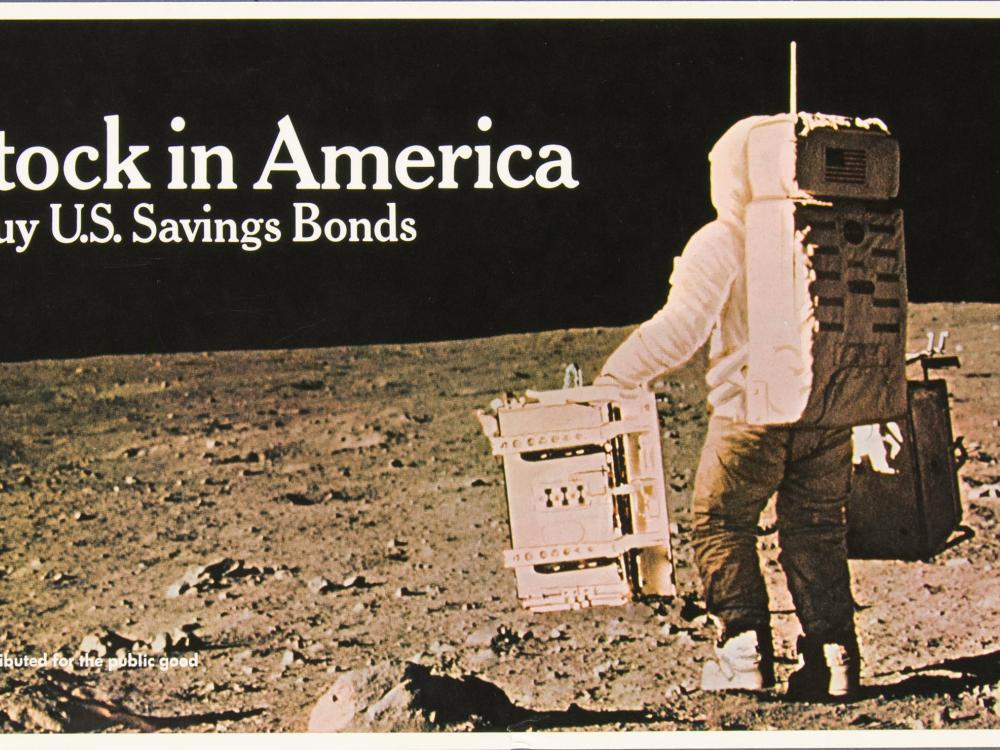
Iconic Apollo Photography Sells Savings Bonds
Jul 21, 2016

Jul 21, 2016
On July 20, 1969, Neil Armstrong stepped onto the lunar surface, and the U.S. Treasury turned to America’s newest space heroes to fundraise. In 1970, the Advertising Council began one of the Treasury’s longest running Savings Bond promotions, “Take stock in America.” One of the first posters produced for the promotion is a photographic assembly depicting the United States’ conquest of the Moon.
The use of photography in advertising became popular in the 1930s following its success in print magazines like Life. Advertisers realized that the public perceived photographs as more “real” than drawn or painted images. Despite the perception of being real, advertisers often manipulated photographs to create new compositions to tell the right story.
As a civilian government agency, NASA’s photographs are in the public domain. They are free and available to use, not just by other government agencies, but also by public and private entities. The photos used in the poster were manipulated to capitalize on the iconography of the space program.
The core of the poster is a photograph taken by Neil Armstrong of fellow astronaut Buzz Aldrin carrying a laser reflector and passive seismometer experiment packages. Designers cropped the image to highlight the astronaut.
Earth was not in the background of the original photograph; Aldrin is seen alone in the vastness of space. But without Earth, there are no human beings or community for which to sell Savings Bonds. To remedy this, designers added an image of the Earth taken from the Apollo 11 command module prior to the lunar landing. Designers cropped, rotated, and placed the Earth to the right of Aldrin to create the composite image used in the poster.
Astronaut-created photographs were powerful tools used during the Space Race era to promote NASA as well as other government and private industries. Curator Jennifer Levasseur writes in her PhD dissertation, Pictures by Proxy: Images of Exploration and the First Decade of Astronaut Photography at NASA, astronaut photography stemmed from a long tradition of exploration photography and highlighted the rhetoric of “competition, commercial opportunity, and scientific discovery.” Not only did the highest levels of NASA management use them to promote and perpetuate support for NASA programs, but they were also used to promote sales like the Treasury’s “Take stock in America” Savings Bond campaign. The image of the astronaut as hero, standing on the Moon, and looking back at his home planet would have evoked not only the victory of the United States in the race to the Moon, but also the victory of humankind in the trajectory of technological progress.
While the poster features Buzz Aldrin, viewers would not have known that fact. The astronaut, on the Moon, with his back to the viewer could be anyone. Anyone could be that hero. The Ad Council was reviving the powerful myth of the lone helmsman – a man in charge of his own destiny. As Levasseur states this works because, “We can put ourselves in the shoes of those we see [in photographs], no matter the strangeness of their clothing, means of transportation, or surroundings.”
The poster used iconic imagery to create a scene in which the viewer could live vicariously as the astronaut-hero, a man merged with technology, a master of the heavens, and hopefully a proud Savings Bond owner.
How does the “Take stock in America” poster make you feel? Could you see yourself in the astronaut’s place?
We rely on the generous support of donors, sponsors, members, and other benefactors to share the history and impact of aviation and spaceflight, educate the public, and inspire future generations. With your help, we can continue to preserve and safeguard the world’s most comprehensive collection of artifacts representing the great achievements of flight and space exploration.